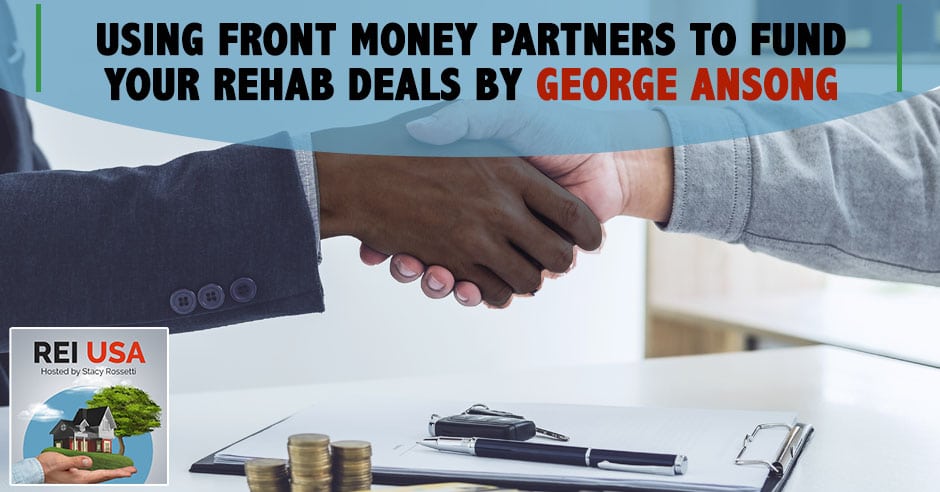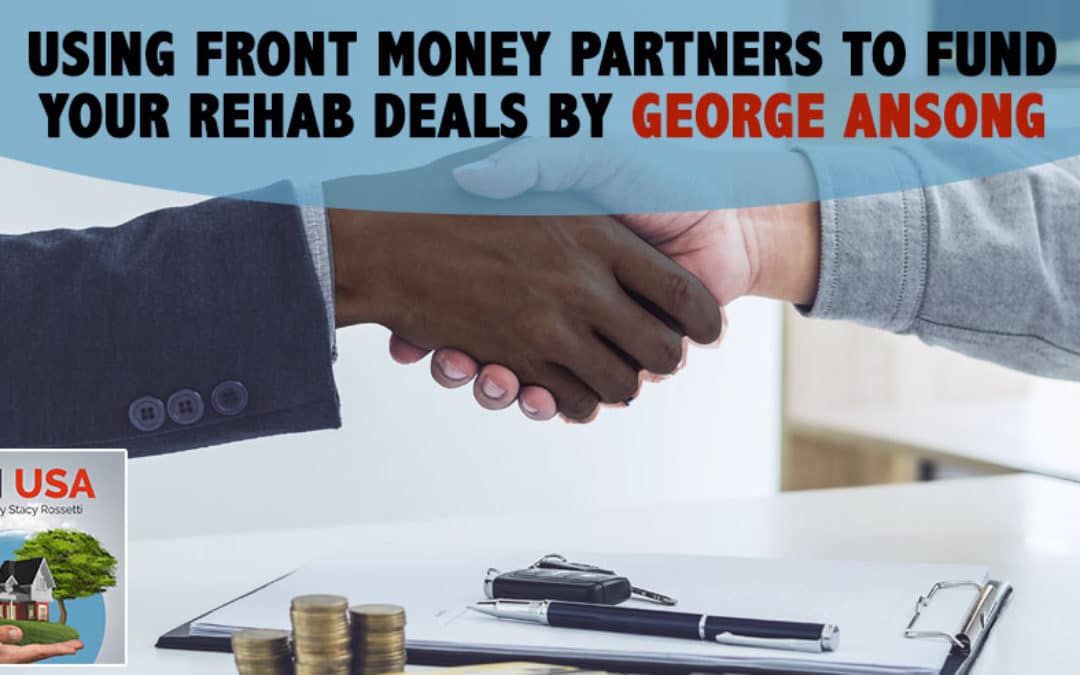
In this episode, George Ansong shares his expertise working with real estate investors to raise money and fund his projects or rehabs. He also uses his knowledge to conduct seminars and teach students about real estate investing. What’s interesting is they even have real estate field trips sometimes. So, stay tuned to learn how you can use front money partners to fund your rehab deals through the examples and scenarios and some tips when dealing with these partners! Plus, take a deep dive into understanding soft cost in a rehab deal and structuring the deal—debt or equity—with the split funding.
—
Watch the episode here
Listen to the podcast here
Using Front Money Partners To Fund Your Rehab Deals By George Ansong
George Ansong here. I’m an investor, realtor and entrepreneur. I’ve been in this business for a long time. I bought my first property in the 1980s in New York City when I took a no-money-down seminar. I bought a few properties in New Jersey before I moved over here with my family in the 1990s. I formed a company called Quadrant Investments with a partner. We bought, fixed and sold properties.
I experienced a market crash in 2008 and 2009. I lost some money and fortune but we came back. I have been teaching real estate investment in area colleges, including Kennesaw State University. In the early 2000s, I wrote all my instructional manuals. I organized real estate mentoring and coaching programs for my students. We went on field trips.
I have a company called GAV Capital Partners where we buy, fix and sell properties. I teamed up with a construction company, Kerman Enterprises, which we have had for many years in this business. I have written a book called The Cashflow Real Estate Agent: A Step-by-Step Guide to Working with Investors. It’s on sale on Amazon and Barnes & Noble. You can also check out my website, www.TheCashflowRealEstateAgent.com. I’m mostly a real estate agent or realtor. I have to disclose that. My specialty is working with investors.
The topic that we’ll talk about is raising capital. Raising money, whether it’s derived from investors, family, friends or borrowed from commercial lenders, is one of the most crucial elements in any real estate transaction. I’m very happy when Stacy met with a consultant that told her that one of the biggest areas that she has to do was raising capital. I believe with all my heart that that is the heart of being a real estate investor.
One of the limiting factors when it comes to investing is capital. The ability to raise capital is very crucial. Always remember that real estate investment is capital intensive. I don’t care how much money you have. If you buy 2, 3 or 4 properties, you’re going to run out of money. The key is how are you going to be able to raise money if you go do a lot of deals? That is the question.
[bctt tweet=”One of the limiting factors when it comes to investing is capital.” username=””]
In my view, an important skill to master is the ability to raise money. That’s why I’m very excited that, Stacy, the Founder organized this virtual seminar so that some of us can explain how we raise money. I’m going to do my niche on how I raise money for my deals. The topic is using fund money partners to fund your rehab deals. I’ve been in real estate for a long time but over the long time that I’ve been doing all kinds of different things, my concentration is buying, fixing and then selling. I’m going to use what I do as an example of how I raise money for my deals.
We are going to talk about soft costs in a rehab deal, understanding soft costs and what is a soft cost when it comes to raising money for your rehab deals. I’m also going to talk about novice rehab numbers. In my view, before I go to convince fund money partners to get involved in my deals, I have to show them what the numbers look like.
The next thing is structuring the deal. I’m going to explain what I mean by structuring the deal or split funding. I said raising money with fund money partners. The question is when I say fund money partner, what do I mean? It is a friend, family, business partner or anybody you can tap into to raise money to fund your initial costs in a rehab project.
When we are doing a rehab project, we have to have initial money to fund a soft cost. In a typical rehab, you have soft costs that you have to deal with because hard money or private lenders do not fund your rehab cost. The sub cost has to come from somewhere and that is where my fund money partners come in. You might ask, what are soft costs? Soft costs are any expense item that is not considered direct construction costs.
Soft costs would include permits, for example, surveying and engineering costs. For example, in Atlanta, if you buy a house and maybe you want to cut the trees, you have to go to the city for them to give you a permit to cut those trees. There is also a down payment, interest payment, dumpster rental and temporary power pole. Sometimes, there might not be electricity on the property so you have to go to the power company to erupt a temporary power pole so that you’re able to bring electricity into their property.

Money Partners: The key is how you’re going to be able to raise money if you go to do a lot of deals.
There is also trash removal, insurance payment, utility payment and miscellaneous. These are all called soft costs. These costs the hard money lender or the private lender to finance that so we have to raise the money from a fund member, business partner or a friend. It might be $60,000, $70,000 or whatever amount that we need. We have to raise this money before we are able to go to a private lender to get our actual funding.
Let me run two numbers to show you how we do it in my rehab budget. Normally, because I have a niche in what I do, in most of my rehab, we sell it for about $500,000 and more. Most of the money that we have to raise from the fund money partners to be able to fund this can reach $50,000, $60,000, $70,000 or $100,000.
I am going to explain how we are able to convince our fund money partners to lend us some money. In this case, we have a property that we are going to sell for $695,000. In that area that we buy in, these are the prices that we sell the properties for. We use a formula that we call the rule of 70. We multiply the after-repair value, which is $695,000 by 70%. We get $486,500.
With the property that we’re going to buy, the repairs are going to cost us about $190,000. With the rule of 70, the $486,500 tells us how much we have to buy the property for and how many repairs we have to include in their purchase. Purchase and repairs come to $486,500. We bought a property for $296,000. It’s going to cost about $190,500 to repair. The gross profit is $695,000 minus $485,500. Our gross profit is $209,500. That is what we’re going to get.
We are able to convince our fund money partners that if the loan is X amount of money, $60,000, $70,000 or whatever it is, we’ll be able to pay them through the gross profit that we get. Before I go to a private lender or hard money lender, I tap into my fund money partners to raise the soft costs that I need for my deals.
[bctt tweet=”Your concentration should be on buying, fixing, and then selling. ” username=””]
Let’s move on to how to structure a deal. Normally, we do something that I call split funding. There are two basic ways to raise funds for a deal. We have what we call debt funding. Debt funding is where we borrow the money and pay interest on the borrowed money. We normally only do simple interests. For example, when we borrow $60,000 from my fund money partner, I will pay them 3% interest per month. The $60,000 per month will come to $8,000 a month. If you borrow for 12 months, we go to all the fund money partners to raise $21,600. That is the debt funding.
We also have equity funding. Equity is where they participate in how much profit we are going to make in the deal. For example, if the project generates about $100,000 in net profit, an investor on that might agree upon a percentage of 10% equity interest. The investor receives 10% interest in their project. That equals about $10,000. The investor will receive $21,600, which is the 1st interest that we’ll pay them plus the $10,000, which is $31,600.
If they invest, $60,000, that is how much they’re going to get at the end of the project. In this case, the ROI is $31,600 divided by $60,000, which is almost half the amount. 52.66% is a very good return on their investment. In split funding, we pay interest on the money that we borrow and as an incentive, we also give them equity interest in the deal that we’re doing. That’s how I structure the deal when I work with my fund money partners. That loan is the initial money for us to get money for the soft costs.
Somebody said, “How do we get out our soft costs back?” Whenever we go to the hard money lenders, throughout their loan, they are able to give soft costs so we will have money for our fund money partners too. They will get the money that you put in for the interest. That’s very important. I will explain the dos and don’ts in raising money from partners. In my view, you should give as detailed information as you can to satisfy your fund money partners. The information that we give to them is the property analysis that we do to let them know that there is enough money for us to pay them back. That is what I mean by the detailed information or analysis.
The next one is that we’ll let the project analysis sell the deal. When you do the analysis, they know that you’re going to make money. That is what we use to convince them to invest in our deals. Another thing you have to realize is that investors can sometimes be intimidated by too much information. We give them information but we don’t go into so much detail that sometimes they get intimidated and too confused. Remember to always give that potential asset upside.

Money Partners: In a typical rehab, you have soft costs that you have to deal with because hard money or private lenders do not fund your rehab cost.
Another thing that you have to do when you’re raising money is to consistently communicate with your investors. Do you know how if you don’t communicate with them, they might think that something is wrong? It’s like that. You have to always communicate monthly or weekly. You have to let them know what’s going on. It’s very important.
Please do not wait until your investors ask for information. Keep all your investors and partners in the loop, especially when you have a good report. Let them know what’s going on. Don’t wait for them to reach out to you because they always think the worst thing will happen. Always take the initiative to keep them updated with what’s going on.
Ensure that investors know the objective. For example, I can make periodic cash because my project ran into difficulties. Sometimes, a project might run into difficulty and might need more money. When you are pitching, you also have to say, “It’s possible that we might come back to you to ask for some more money.” Let them know that because that means sometimes, things happen.
The next thing is to always make provisions for how investors can divorce themselves from the investment and for someone to have the right of first refusal. We also try to make provisions. For example, a fund money partner invests an X amount of money and we’re supposed to give them the money in maybe twelve months. Maybe in the tenth month, something happens and they want to get their money back. We have a provision where they can let us know so that we can get any of the partners that are also involved that want to buy their interest. We have to make provisions so that in case anything happens and they want to get your money, they’ll be able to get out of it.
The last thing is that the terms need to be spelled out succinctly so that they knew exactly what you did. Things happen so they have to know like, “You’ll be paid in 12 months or 6 months.” Everything needs to be spelled out. I want to talk about a case study that I’m involved in. My group has been able to put together about $250,000 that we’ll be investing in a new subdivision.
[bctt tweet=”Investors can sometimes be intimidated by too much information.” username=””]
A subdivision is going to combine and we have the opportunity to participate in this subdivision. It’s a little bit complicated so we have to hire an attorney to put everything together because it is the first time that we’re getting involved in such a big deal. The returns that the developer has promised are pretty good. It’s 33% of the net profit.
The net profit of that development is going to come to $2.4 million and we get about 33%. Apart from that, because I’m a realtor, they have given my company about seven units to sell. That is in addition to the profit they have given us. Apart from that, one of my partners that is also involved in raising the money does flooring. The developer is also going to give him about sixteen units. He is going to do the whole flooring. That’s the return that we are going to get.
When you are doing deals or raising money, you can structure it in any way that you want. It doesn’t matter. I like to stick to split funding because we’re able to say, “We can give you a certain amount of money on your interest and then you can also participate in the upside.” Uniquely, that’s how I do my deals and how I raise money to fund my deals.
The majority of the money is going to come from private lenders or hard money lenders. If we’re doing 3 or 4 projects and the initial cost is $60,000, $70,000 or $80,000, that’s a lot of money so we try to reach out to my partners and friends. Some people also recommend other people that might have money to participate in there.
My name is George Ansong. GAV Capital Partners is a company that I formed that works and partners with investors to do deals. As an agent, I have to disclose that I’m also a real estate agent. If there are any questions, I’ll be more than happy to answer them. Thank you very much for the opportunity to participate in this program.

Money Partners: There are two basic ways to raise funds for a deal: debt funding and equity funding.
Thank you so much. Tell everybody when you teach for REI USA.
It’s the second Thursday of the month.
At what time?
6:30 PM.
Is it Eastern Time?
Yeah.
George can help you with rehabbing, rentals and custom building.
Important Links
- Kerman Enterprises
- The Cashflow Real Estate Agent: A Step-by-Step Guide to Working with Investors
- Amazon – The Cashflow Real Estate Agent: A Step-by-Step Guide to Working with Investors
- Barnes & Noble – The Cashflow Real Estate Agent: A Step-by-Step Guide to Working with Investors
- https://www.REI-USA.com/George-Ansong/
- www.REI-USA.com
About George Ansong
 GEORGE ANSONG – Real Estate Guru, Realtor, Entrepreneur, Investor, Teacher, Lecturer, Coach, Mentor
GEORGE ANSONG – Real Estate Guru, Realtor, Entrepreneur, Investor, Teacher, Lecturer, Coach, Mentor
“The cave you fear to enter holds the treasure you seek.” ― Joseph Campbell
George Ansong is the ultimate entrepreneur. Starting as a cab driver in the early 1970’s in New York City, he discovered his passion in real estate investing when he attended a “No Money Down Seminar” and met his mentor Mr. Tyler Hicks of International Wealth Success (IWS) Fame. He bought his first property in Brooklyn, NY – a multi-unit property that he later sold. He then bought a few properties in the Jersey City area before moving to Atlanta with his family in 1990. He bought and sold a few businesses and with his knowledge in real estate investing started teaching real estate investment courses at area colleges, including Kennesaw State University, Chattahoochee Technical Institute and Perimeter College. As an adjunct instructor Mr. Ansong wrote all his instructional manuals which are now ebooks on various topics on real estate investment.
He later formed a company, Quadrant Investments LLC with his partner where he and his money partners bought and sold over $50 million worth of real estate before the market crashed in 2008. He obtained his Real Estate License in 2000 and worked as Agent for Property Systems of GA , one of the leading foreclosure Real Estate Brokerage companies in the Southeast where his focus was working with real estate investors. During this time, Mr. Ansong was teaching, conducting seminar, and organizing real estate field trips for his students. He later worked for Prudential Georgia Realty, now Berkshire Hathaway HomeServices. Currently Mr. Ansong is now a Realtor with Maximum One Realty in Atlanta, Georgia. His specialty lies in working with real estate investors! He has a company GAV Capital Partners LLC., where he works with investors rehabbing and selling high end homes in the Atlanta area. He is also writing a book: The Cash Flow Real Estate Agent – www.thecashflowrealestateagent.com – which will be published in the fall. Mr. Ansong is a graduate of Bernard M Baruch College of the City University of New York (CUNY) with a degree in Business Administration. His hobbies include reading, travelling and listening to music.

